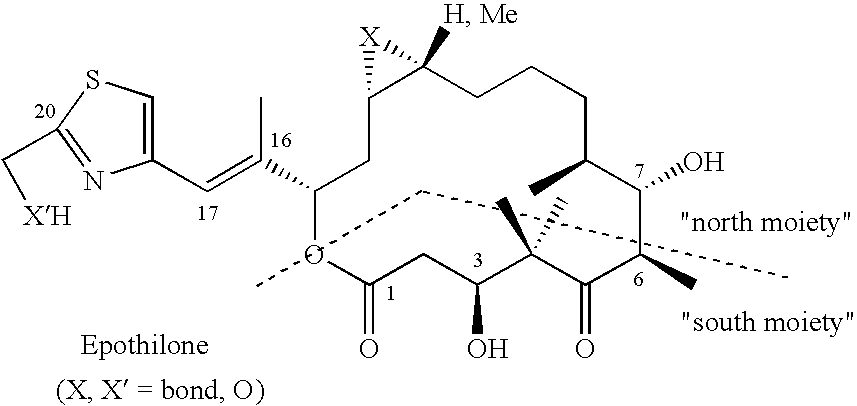Epothilone synthesis building blocks iii and iv: asymmetrically substituted acyloins and acyloin derivatives, methods for their production and methods for the production of epothilones b, d and epothilone derivatives
- Summary
- Abstract
- Description
- Claims
- Application Information
AI Technical Summary
Benefits of technology
Problems solved by technology
Method used
Image
Examples
example 1
Part A—Synthesis of Racemic O-acylacyloins and their Precursors
tert-Butyl-2-acetoxy-2-acetyl-4-hexenoate
3.24 g (15.0 mmol) tert-butyl-2-acetoxyacetoacetate is added to a suspension of 660 mg (16.5 mmol) sodium hydride in 30 ml DMF at 0° C. After termination of the gas formation, 2.00 g (15.0 mmol) 1-bromium-2-butine is added at 0° C. The orange colored solution was stirred for 40 min, and was brought to room temperature in 15 min. After addition of 120 ml diethylether, several washings with water were performed and a final wash with concentrated sodium chloride solution. The organic phase was dried with Na2SO4, filtered, and the solvent was removed in vacuo.
Yield 3.83 g (14.3 mmol, 95%).
Rf value approx. 0.57 with ethylacetate / hexane=1:4.
3-Acetoxy-5-heptine-2-one
1.61 g (6.00 mmol) tert-butyl-2-acetoxy-2-acetyl-4-hexenoate, 114 mg (0.60 mmol) para-toluenesulfonic acid monohydrate and 20 ml benzene are stirred for 2 h at 78° C. 2 h. After termination of the reaction (after gas format...
example 2
The listed compounds may also be isomere mixtures, racemates, and / or diastereomers, if not mentioned explicitly otherwise. Compounds enriched with enantiomeres are usually indicated by listing a rotation value. If desired, the resulting products were purified by purification procedures known in the art.
1. Tert-butyl-2 bromo-acetoacetate
N-bromo-succinimide (58.7 g, 330 mmol) was added in portions to a solution of tert-butyl acetoacetates (49.0 ml, 47.5 g, 300 mmol) in Acetone (30 ml). The resulting solution was stirred for one hour at ambient temperature, and subsequently filtered. The filtrate was vacuum concentrated, and the residuum was reconstituted in 300 ml petroleum ether. After washing three times, each time with 100 ml water, the solution was dried over Na2SO4 and filtered. Then, the product was obtained by vacuum concentration.
2. Tert-butyl-2-acetoxy-acetoacetate
A solution of glacial acetic acid (10.6 ml, 186 mmol) in DMF (169 ml) was neutralized with triethylamine (25.8 ...
example 3
The following example compounds are produced according to methods as described in Example 1 or 2 or in the description (standard reactions are described in R. C. Larock, Comprehensive Organic Transformations, VCH, 1989, ISBN: 0-89573-710-8).
(1E,5Z)-1-(2-Methylthiazol-4-yl)-3-acetoxy-2,6,10-trimethyl-undeca-1,5,9-triene
93 mg (0.27 mmol, 67%).
C20H29NO2S (347.52).
(4E)-2-Acetoxy-2-acetyl-5,9-dimethyl-deca-4,8-diensäure-tert-butylester
Yield: 17.6 g (50 mmol, quant.).
MS (EI): m / z (%)=352 (0.01, M+), 296, 236, 193, 167, 153, 69, 57, 43 (100.0).
C20H32O5 (352.47).
(5E)-3-Acetoxy-6,10-dimethyl-undeca-5,9-dien-2-one
Yield: 11.66 g (46 mmol, 92%).
MS (ESI-MS): m / z (%)=253.0 (100) [M+H]+, 209 (42) [M−COCH3]+, 193 (23) [M+H—AcOH]+.
C15H24O3 (252.35).
(5E)-3-Acetoxy-11-hydroxy-6,10-dimethyl-undeca-5,9-dien-2-one
Yield: 1.63 (6.07 mmol, 27%).
C15H24O4 (268.35).
(5E)-Acetic acid 4,8-dimethyl-1-(2-methyl-[1,3]dioxolan-2-yl)-nona-3,7-dienyl ester
Yield: 5.78 g (19.5 mmol, 97%).
C17H28O4 (296.40).
(5E)-Aceti...
PUM
| Property | Measurement | Unit |
|---|---|---|
| Mass | aaaaa | aaaaa |
| Mass | aaaaa | aaaaa |
| Mass | aaaaa | aaaaa |
Abstract
Description
Claims
Application Information
 Login to View More
Login to View More - R&D
- Intellectual Property
- Life Sciences
- Materials
- Tech Scout
- Unparalleled Data Quality
- Higher Quality Content
- 60% Fewer Hallucinations
Browse by: Latest US Patents, China's latest patents, Technical Efficacy Thesaurus, Application Domain, Technology Topic, Popular Technical Reports.
© 2025 PatSnap. All rights reserved.Legal|Privacy policy|Modern Slavery Act Transparency Statement|Sitemap|About US| Contact US: help@patsnap.com



